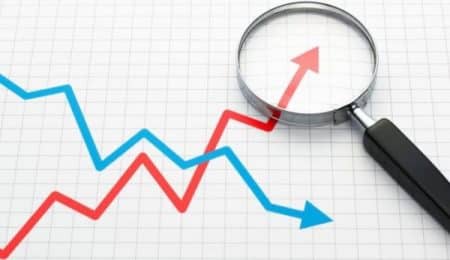When new and existing businesses have a visual reference that provides an overview of expected outcomes and trends, they tend to function better. When planning for the future, successful businesses frequently incorporate forecasting models.
In this article, we will look at how the most common types of forecasting models are used in business and get an overview of how to create basic models like the time series model.
What are Forecasting Models?
Forecasting models are one of many tools used by businesses to predict sales, supply and demand, consumer behavior, and other outcomes. These models are particularly useful in the fields of sales and marketing. Businesses use a variety of forecasting methods that provide varying degrees of information. The appeal of using forecasting models, from simple to complex, stems from having a visual reference of expected outcomes.
Types of Forecasting Models
While there are numerous methods to forecasting business and financial outcomes, there are four major types of models or methods that businesses use to predict future actions. With the following examples of common forecasting models, you’ll have a better understanding of how companies use these methods to improve their business practices and the customer experience:
- Time series Forecasting Models
- Econometric model
- Judgmental forecasting model
- The Delphi method
#1. Time series Forecasting Models
This is one of the types of forecasting models that relies on historical data to provide accurate forecasting. When you understand how variables interact over time (hours, weeks, months, or years), you will be able to visualize data patterns more effectively.
While there are various methods for building time series forecasting models, you can estimate outcomes utilizing knowledge gained from recent analytical data by following these broad stages in a spreadsheet:
- Have your time-based data ready to go (time series and values series).
- In the first column, enter the compiled data involving time or duration.
- In the next column, enter the remaining values you want to forecast.
- Choose relevant data.
- Click the Data tab, then the Forecast Group, and finally the Forecast Sheet.
- Access the sheet, then choose between a line graph and a bar graph.
- Determine your end date in the Forecast End box and click Create.
After you’ve created your time series forecasting models, you’ll need to interpret them in order to make your best predictions for the future of your business.
#2. Econometric Model
Economists frequently use an econometric forecasting model to forecast changes in supply and demand, as well as price changes. Throughout the creation process, these models incorporate complex data and knowledge. This type of statistical model, as the name implies, is useful for forecasting future economic developments.
The basic structure of this type of forecasting model is as follows:
- Determine your independent and dependent variables. Which economic relationship do you want to put to the test? For example, you could inquire, “Does X have an effect on Y?”
- Create a hypothesis to put this relationship to the test. Consider other variables that could affect “Y” and label them “Z,” also known as the control variables.
- Collect the data set that includes “Y,” “Z,” and “X.”
- Plot this data to see if there are any anomalies or outliers.
- Determine whether the relationship between “Y” and “X” is linear, quadratic, or another type of relationship.
- Calculate the transformations using a mathematical method that you are familiar with.
- Interpret the impact of “Y” on “X.” What does “X” mean in relation to your hypothesis?
To further analyze your findings, add the “W” variables to this regression.
#3. Judgmental Forecasting Model
To make predictions, various judgmental forecasting models use subjective and intuitive data. For example, there are times when no data is available for reference. When launching a new product or dealing with volatile market conditions, judgmental forecasting models come in handy.
Some characteristics of judgmental models are as follows:
- Approaches the problem from a subjective, opinionated standpoint.
- Specific variables are assumed.
- It has limits.
- With the inclusion of additional information, accuracy improves.
This form of forecasting model is extremely useful in the realm of research and development. Focus groups and expert panels can provide insight that no computational model can. Companies, for example, might better analyze their direction while developing specific product features by surveying a group of individuals about what they look for in a product.
#4. The Delphi Model
This method is widely used to forecast trends based on information provided by an expert panel. This procedure is based on the Delphi method, which is concerned with the Oracle of Delphi. It is assumed that answers produced by a group are more useful and unbiased than answers offered by a single individual. The overall number of rounds engaged may vary based on the researchers’ goals at the organization or group.
These experts respond to a series of questions in rounds that eventually lead to the “correct answer” that a company is looking for. The accuracy of the information improves with each round as the experts revise their previous assumptions in light of new information provided by other members of the panel. The method concludes when a predetermined metric is met.
The following are the steps you can take to in creating your own judgmental forecasting models:
#1. Choose a facilitator.
Consider the neutrality of the individual and the person’s research experience before selecting a facilitator to manage the discussion. This position could be chosen by the head of research and development, for example.
#2. Select your specialists
When a company conducts research on a product that is not yet on the market, it relies on a panel of anonymous experts to provide feedback. Experts can be anyone with extensive knowledge of a particular subject. In the case of designing a new swim product, for example, a corporation may contact instructors or safety experts in the field. They might even approach professional athletes or long-term clients who utilize similar items.
#3. Specify the issue
Companies seeking to fix a problem must first disclose the specifics around the situation, as well as any essential details that will assist them in making an informed conclusion. This ensures that everyone knows what is expected of them. Businesses may wish to develop a novel monofin with features that none of their competitors have attempted.
#4. The first round of questions
This first set of questions introduces the topic and kicks off the discussion. The experts will read the information, provide anonymous feedback, and return it to the facilitator.
#5. Second round of questions
After reviewing the panel’s responses, editing content, filtering out extraneous data, and scanning the content for common themes, the facilitator provides new information to the panel. Members of the panel can study prior responses anonymously and resubmit a response to another’s statement based on the new knowledge. They resent their responses to the facilitator.
#6. Third round of questions
Before sending out the surveys to the panel, the facilitator will check the new responses and filter through the material offered for the perhaps final time. However, the procedure may be repeated until a widespread consensus is reached, which could take three or four iterations.
#7. Take some action
Once the researchers have gathered enough information, they can proceed with any plans to put their findings into action. This could be the commencement of fresh product development or the start of manufacturing on an item about which they are unsure.
Methods of Artificial Intelligence (AI)
Companies in the realm of technology utilize artificial intelligence (AI) methods to forecast a specific area of growth. So, using mathematical algorithms, these forecasting models produce remarkably precise outcomes. The technology underpinning artificial intelligence anticipates a wide range of user outcomes and aids in the generation of “you may also enjoy” suggestions that display on specific websites.
Here are some examples of common artificial intelligence forecasting methods:
#1. Product and content recommendations
Large online organizations utilize AI to predict client behavior on their sites, including the possibility of a future purchase. In addition, site users obtain recommended products through a process known as “collaborative filtering,” which involves clustering and interpreting consumer data in conjunction with profile information and demographics. So, more data leads to better results.
Assume you’re browsing a popular online buying site and come across a board game called “Fender Bender.” If you go down to the bottom of the web page, you will see that related games have been suggested based on individuals who like Fender Bender.
#2. Search engine accuracy
Artificial intelligence methods drive the accuracy of the results you see on the search engine optimization page (SERP). Google uses a machine-learning algorithm to offer excellent results to searchers, and other companies in the e-commerce sector are also using similar artificial intelligence techniques to improve their search engines as well.
Assume you’re using a prominent search engine to look up “boots for women.” When you click the search icon, you are sent to a page of results that include women’s boots. Many of them provide winter boots, dressy boots, rain boots, and other ideas, so you refine your search even more by typing in “winter boots for women,” then clicking the search button again to see a more curated list of results.
#4. Predictive analytics
Companies employ artificial intelligence to improve customer service by analyzing data sets and anticipating future trends. Using the information offered by AI technology, call center managers can make judgments regarding the amount of personnel needed to staff a specific day or week.
For example, a call center manager checks his computer software to see how many calls the organization may receive that day. So, he decides to hire four workers and let the rest of the crew take the day off.
Conclusion
Forecasting models enable a business to take the necessary steps to attain a specific objective by providing crucial knowledge about future events, including their incidence and size. Forecasting can be qualitative or quantitative, depending on the information gathered and its nature, which is usually subjective or objective, and is thus dependent on mathematical calculations or no mathematical calculations at all.
So, according to the business, management decides on the best forecasting models to apply. It is dependent on internal and external elements, as well as whether or not the external factors are controllable. Government regulations, competitive strategies, natural disasters, and other uncontrollable circumstances can all be examples of uncontrollable factors.
Forecasting Models FAQ’s
What are the two categories of quantitative forecasting models?
The two categories of quantitative models include time series models and causal models.
Which type of forecasting approach qualitative or quantitative is better?
Though quantitative techniques have been shown to be more accurate than qualitative techniques, they cannot be employed in all instances, especially where good quality and reliable historical data is not available.
How do you explain forecast accuracy?
Forecast accuracy is the difference between actual and projected demand. If you can assess the level of error in your previous demand projections, you can factor it into future ones and make the necessary changes to your planning.






